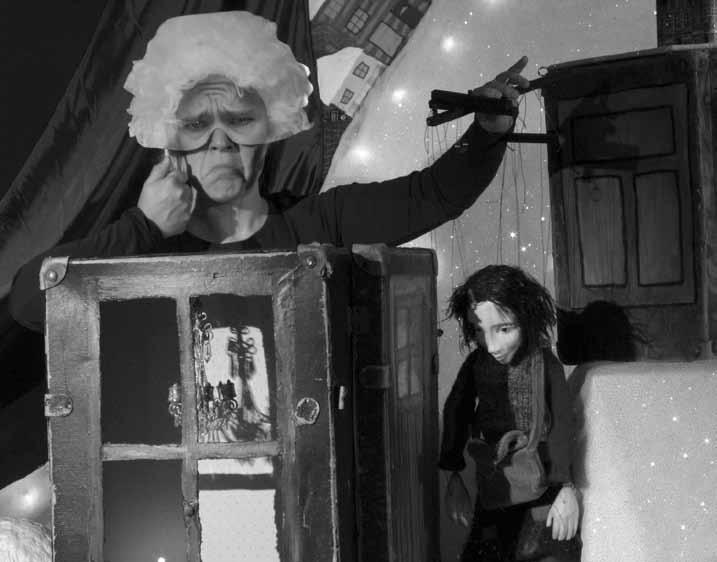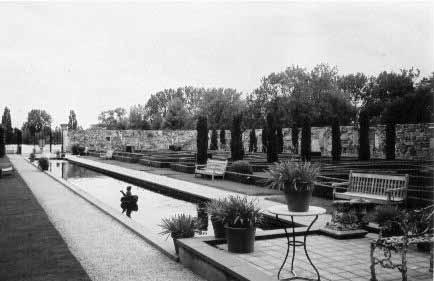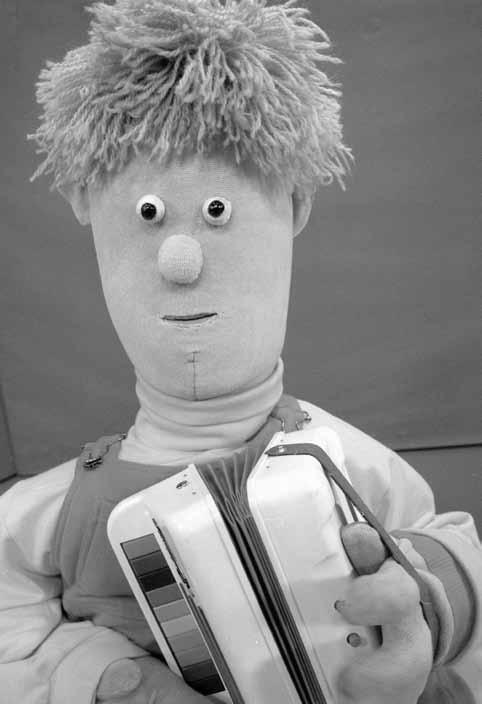
29 minute read
Finland-Swedish Puppetry
tavasta. Batujeva oli vahva ja vaativa draamaihminen, jonka nukketeatteriesityksissäkin piti olla draamaa ja rytmiä, nukeissa vahvat karaktäärit. Nalle Puhia harjoiteltiin pitkään, mutta sillä oli vain yksi julkinen esitys ohjaajan ja esittäjien välisten ristiriitojen johdosta.
Marianne Kinberg oli tässä vaiheessa jo valmistunut tekstiilitaiteilijaksi Taideteollisesta oppilaitoksesta ja työskenteli päivät sisustusliikkeessä. Töiden ohessa hän harrasti nukketeatteritoimintaa ja teki nukkeja myös nukkefilmeihin, joissa oli satuja eri maista. Ammattinäyttelijät, mm. Ritva Vepsä ja Seppo Kolehmainen tekivät nukkien äänet ja näyttelivätkin tallennuksissa. Filmejä kuvattiin mm. Suomenlinnassa, missä Vihreän Omenan Lea Wallin avusti nukkenäyttelemisen saloissa. Vuonna 1974 Marianne Kinberg perusti Nukketeatteri Pan´in. Hänen veljensä Klaus Hanén oli kirjoittanut näytelmiä kahdesta villistä pojasta nimeltään Rymy ja Rämä. Lisäksi ohjelmistossa oli mm. Rapu räätälinä ja Jasper-setä lastenkutsuilla sekä Putte Possun nimipäivät paperinukkeversiona. Marianne Kinbergin lukioikäinen poika Tuomas markkinoi näytöksiä mm. firmojen ja yhdistysten lastenjuhliin. Esityksiä kertyi parikymmentä vuosittain. Marianne Kinberg veti lisäksi lapsille päiväkodissa nukketeatteria, jota lapset esittivät Kinbergin tekemillä nukeilla. Nukketeatterikursseja hän piti aikuisille, mm. Kalliolan vapaaopistossa ja opettajaopiskelijoille Jyväskylän yliopistossa.
Advertisement
Vuonna 1978 Marianne Kinberg muutti Ruotsiin, missä hän jatkoi päivätöidensä ohella Nukketeatteri Pan´in toimintaa. Ruotsinsuomalaisten keskusliitto ja Arbetarnas Bildningsförbund tilasivat häneltä esityksiä ja nukketeatterikursseja. Myös Invandrarverket (Maahanmuuttovirasto) työllisti Kinbergiä, joka työskenteli nukketeatteriohjaajana kouluissa sekä ruotsinsuomalaisten että muiden maahanmuuttajalasten parissa. Nukketeatteri Pan´in toimintaan tuli mukaan Liisa Siltavuori ja hänen jälkeensä Paula Sandelin. Kinberg teki lapsille mm. näytelmän Ruotsiin lähetetyistä sotalapsista. Ohjelmistossa olivat myös kaksikieliset nukketeatterinäytelmät Kultalintu ja Kuka sanoi Miau / Vem sade Miau? Ruotsissa Marianne Kinberg piti myös nukketeatterikursseja aikuisille ja osallistui monille huipputaiteilijoiden vetämiin koulutuksiin. Vuonna 1994 Marianne Kinberg ryhtyi yhteistyöhön taidekäsityöläinen Pyret SellbergSvedlundin kanssa. Heillä oli Dockteater Pelikanen, joka kiersi esityksillään eri puolilla Ruotsia. Ohjelmistossa oli mm. mysteerionäytelmä, jota esitettiin Visbyn keskiaikamarkkinoilla. Pelikanen lopetti toimintansa vuonna 1998, jolloin Marianne Kinberg muutti takaisin Suomeen. Hän pakkasi matkalaukkuun Kultalinnun ja muut vuosikymmenten kuluessa tekemänsä nuket. Ne päätyivät Lahden Radio- ja televisiomuseoon, missä Marianne Kinbergin nuket ovat näytteillä vitriineissä.
Vuonna 2000 Marianne Kinberg meni mukaan Nukketeatteri Vihreän Omenan suureen Lumikuningatar-projektiin, missä useat harrastajaryhmät tekivät omia esityksiään Helsingin kulttuuripääkaupunkivuoden merkeissä. Harrastajaryhmä teki myös Pfisterin Kultakala-esityksen, mutta ryhmän toiminta lopahti muutaman esityksen jälkeen. Muutettuaan Lahteen Marianne Kinberg on ohjannut lasten nukketeatteriryhmiä kouluissa ja esittää tällä hetkellä Jaana Kilpeläisen kanssa Sikopaimen-satua miniatyyrinukeilla ruotsinkieliselle päiväkodille.
Maiju Tawast
Lähteet: Marianne Kinbergin haastattelu 29.7.2009 Lahdessa, haastattelija Marjut Tawast Marianne Kinbergin arkistot sekä Lahden Radio- ja televisiomuseo Ota Oma -lehti 3/09, Anneli Enqvistin artikkeli Marianne Kinbergistä
From Kalle Nyström to Atte FINLAND-SWEDISH PUPPETRY
Finnish puppetry has been celebrating its 100th anniversary in 2009. In November 1909, journalist and variety-show artist Kalle Nyström set up the stage of his Marionett-teatern in Hotel KÄMP in Helsinki. He was the first Finnish artist to make puppet theatre as a part of his profession and means of living. And he represented the Finland-Swedish culture, which has very strongly affected the birth and development of Finnish puppetry during the last 100 years. The Swedish-speaking population in Finland consist of only 5-6 per cent of the total population, but their impact on Finnish culture has always been of great importance, even crucial in the field of puppet theatre.
Before Kalle Nyström and the birth of professional puppetry Finland had joined the centuries old and highly developed European tradition of puppet theatre in the nineteenth century. Travelling European theatre troups touring to Stockholm and St. Petersburg visited since 1830s Finland, mainly Helsinki and Vyborg, performing among their repertoire scenes of marionette theatre, metamorphosis puppetry and “theatrum mundi”.
Paper and shadow figures as well as glove puppets were brought to Finland in the 19th century as toy gifts for children in the bourgeois and upper-class families, who had been travelling in Europe. At the end of the century some adults became enthusiastic amateur puppeteers giving performances to small, mainly intellectual and adult audiences, among them the famous Finnish painter Albert Edelfelt. These tableaux usually depicted historical events (e.g. The Battle of Salamis in 1882) as shadow theatre, which the artists had seen e.g. in the Chat
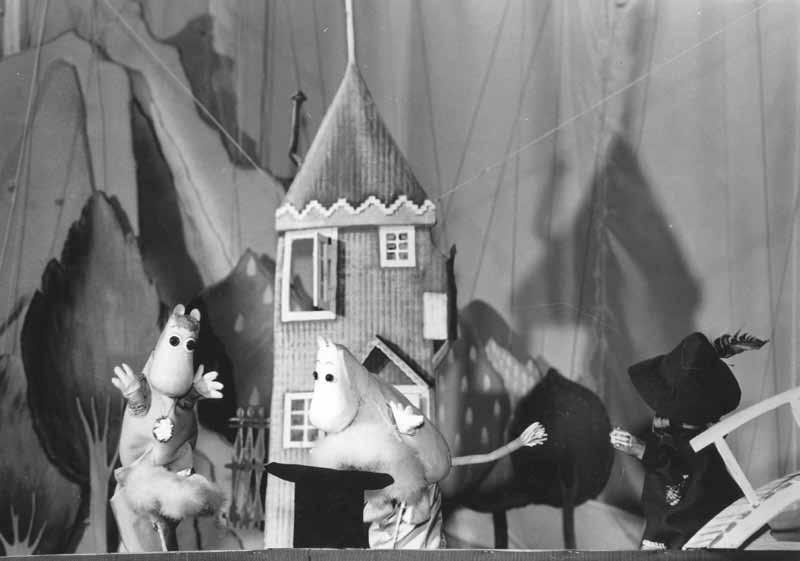
The Moomintroll Theatre, which were made by Signe Hammarsten-Jansson have not been found yet (photo: Teatterimuseo)
Noir Cabaret in Paris, where they went to study painting. Shadow theatre had become very fashionable in all European countries and silhoutte theatre sheets were printed even in Finland, Helsinki by Edlunds Printing House. The only preserved one depicts our national poet´s, the Finland-Swedish Runeberg´s epic poem Fänrik Ståls Sägner / Second Lieutenant Ståls Story. This shadow theatre story was performed in Finland-Swedish cultural families, like the famous Sibelius in Loviisa, every Feburary at the Runeberg Day until 1930ies and even during the Second World War.
Early pioneers
The very first professional puppeteer was Kalle Nyström (1865 - 1933), who in 1909 founded the Marionett-teatern (Marionette Theatre) in Helsinki and ran it continuously for twenty years. He had seen the famous German Papa Schmidt performing in Munich in the beginning of the century. This gave him inspiration to start a regular puppet theatre in Helsinki in 1909 alongside with his career as a variety show author and a journalist. Nyström worked together with professional Finland-Swedish actors and artists of that time. The performances, written and performed in Swedish, were aimed at adult audiences and told satirically of current happenings in artistic spheres and of celebrities such as Sibelius, the national composer of Finland. Kalle Nyström wrote tens of short scenes for his puppet theatre based on Shakespeare, our national epic Kalevala and many variety shows for puppets. For children Marionettteatern gave own performances, fantastic and educational stories by Sakari Topelius. Kalle Nyström´s theatre gave shows regularly in the vaudeville Apollo Theatre in Helsinki and also toured in the Nyland Region. In the weekends Marionett-teatern played in the Helsinki Zoo for children. Nyström´s son Harry worked with his father since 1915 until 1933, when the puppet theatre was closed after the death of Kalle Nyström. The puppets are now at Tampere Vapriikki-museum. The next pioneer in Finnish puppetry was Joel Pettersson (1892-1937), a painter and author who lived in the Åland Islands, where 95 % of the population speaks Swedish. He got interested in puppet theatre in the beginning of 1910s, when he saw some touring foreign puppetry shows in Mariehamn and read in the newspapers about Kalle Nyström´s Marionetteatern. Pettersson started making his own puppetry performances for adults and children, toured around in villages and had a permanent puppetry scene at Lemland Youth Association´s House until 1937. In his plays for adults he had a critical point of view on the life of peasants and city-dwellers. In the style of folk theatre Pettersson depicted love, greed, the rich and the poor in his puppetry shows. Many of his puppets are in the Provincial Museum of Art of Åland Islands. The Åland-based amateur puppet theatre Fågel Blå (The Bluebird) made a puppetry performance on Joel Pettersson´s life in 2003 with a great success.
Bärbi Luther´s pedagogical shadow theatre
In 1914 Bärbi Luther (1898-1979), a teacher and pedagogue in the early kindergartens, began performing with shadow figures for children in kindergartens in Helsinki. The origin of these shadow figures was Germany, where she went for kindergarten teacher education and acquainted herself with Steiner pedagogics and arts education. Bärbi Luther started making her own performances
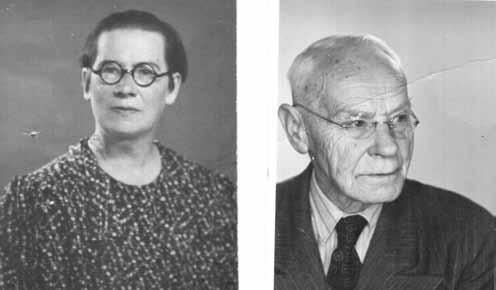
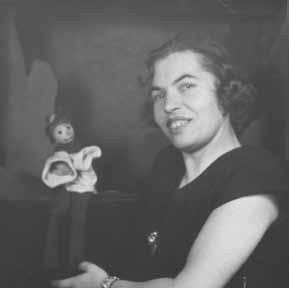
with her sister Märtha, also a kindergarten teacher in Helsinki. They both got acquainted with puppet theatre very early in their childhood at home, where their mother used puppetry as means of children´s education. Bärbi Luther continued her career as a puppeteer for more than 60 years, until 1975 with her performance Per och Brita. It told about a brother and her sister, who wonder in a forest trying to find their way back home. Bärbi Luther´s shadow theatre was pedagogical and poetic, scenes were slow and beautiful. The scenery was made of colored silk paper according to the color schemes of Goethe used in the Steiner pedagogics. Bärbi Luther played puppet theatre also in children´s hospitals, where she worked as an occupational therapist, the very first one in Finland. In her repertory there was also a Christmas Legend ”Det Glada Budskapet” (The Message of Joy), which was made in the 1920ies. The two sisters performed the show until mid 1970ies, when they were retired and donated the whole performance to their goddaughter Frida Packalén (born in 1928). She continued performing the Christmas Legend together with her husband in the Eastern Nyland Province until the late 1990ies. She has been a school teacher using the means of puppetry at her work with children and taught also shadow theatre technics to adults in various courses.
The first art historian depicting puppetry
The Finland-Swedish art historian Yrjö Hirn (1870 – 1952) wrote a book Barnlek: några kapitler om visor, danser och små teatrar (On children´s games, songs, dances and small theatres). It was published in 1916.Hirn dealt with children’s games from an aesthetic and cultural-historical perspective. He studied the artistic expression of high culture but also popular art expressions and the art forms of primitive peoples. Hirn demonstrates the great breadth of puppet theatre as a phenomenon. Following the historical survey, Hirn depicts the various techniques of puppet manipulation using them to analyse puppet theatre’s aesthetic effects. These are to do with the magical/poetical, the comic, the visual/stylized and the equilibristic. Yrjö Hirn’s eye-witness descriptions of contemporary puppet theatre performances in the end of 19th century have a value all of its own as historic sources for an art form with few such references. Hirns interest in puppet theatre was perfectly genuine and his broad theoretical knowledge as a professor of aesthetics, combined with his personal enthusiasm for the subject, makes Barnlek an altogether unusual work where the aesthetic of puppet theatre is concerned.
Early amateur puppeteers
teachers used puppetry in their work as pedagogical means, for instance Ms. Olly Donner at Kirkniemi orphanage and school in Lohja. She and her colleagues made own glove puppets: kasper and harlequin, animals, angels and other Christmas story figures. 13 of these puppets are now at Helsinki City Museum. In Vyborg, next to the Russian border, Harriet (1891 - 1965) and Nikolai (1871 - 1956) Schmakoff started making amateur puppetry and performed shows in family circles, charity events and other occasions. They had been inspired by the German puppetry, especially Harro Siegels performances and his unique style. The Schmakoff´s moved to Espoo, next to Helsinki after the War, when Soviet Union took Vyborg, and continued playing marionette shows, which contained of humoresques, musical etydes and scenes of e.g. The Barber of Sevilla The arias and songs were sung by the famous Ms. Korniloff accompanied by pianist Berg. In 1950, when the Schmakoff couple had seen the famous French puppeteer Jacques Chesnais visiting Helsinki, they gave a few public performances in Koitto Cultural House. After that they continued as occasional amateurs until 1958, when they donated five of their puppets to The Helsinki City Museum.
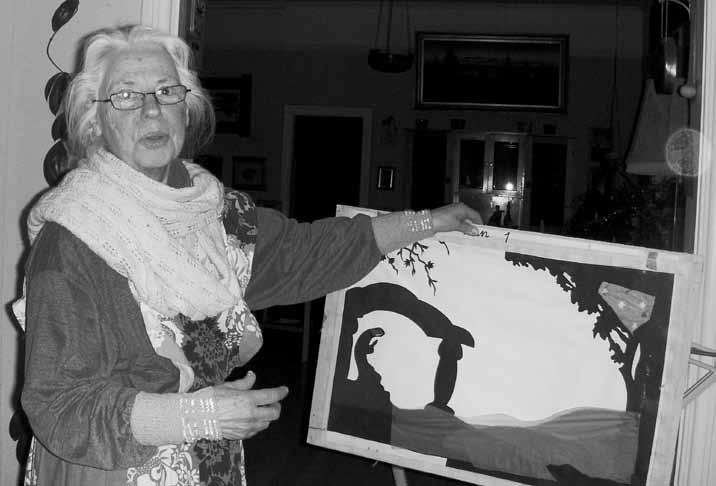
Frida Packalén and the shadow theater of Bärbi Luther
Break-through in the 1950s
After World War II puppet theatres all over Europe sought and found a new language and style. The Finnish puppetry however was for a long time in a lull with a few amateur performers. Two noteworthy companies from abroad visited Finland: in 1949 French puppeteer Jacques Chesnais and in 1950 Russian Sergei Obraztsov. They inspired enthusiasm for puppetry in Finland and Finnish puppeteers began presenting public performances as professional companies The final artistic and international break of Finnish puppetry came in the 1950s with Mona Leo´s lyrical performances in her Helsingin Nukketeatteri - Helsingfors Dockteater (Helsinki Puppet Theatre), which also visited foreign festivals. Mme Mona Leo (1903-1986), the Grand Lady of Finnish puppet theatre, started her own puppetry activities in 1951. Her modern and poetic approach within Helsinfors Dockteater - Helsingin Nukketeatteri (Helsinki Puppet Theatre) was remarkable and had a strong influence on all other puppeteers from the 1950s until the 70s. She brought the Finnish puppet theatre also to an international audience when touring around Europe. Mona Leo concentrated on creating her own puppet theatre, which was small in scale and lyrical, beautiful and mysterious. Her bilingual puppet theatre performed fairy tales and stories for children in kindergartens, hospitals and charity events. She was the first puppeteer (with her assistant Vivi-Ann Sjögren, a professional drama actress) in 1955, who also performed at the very new Finnish Television, where she continued doing puppetry shows until 1964. Mona Leo was mainly a solo performer, but several assistants worked with her as assistant puppeteers, seemstresses, props and set designers. One of the assistants was Marianne Kinberg, who later on worked with several Finnish puppeteers and made puppet theatre also in Sweden. Mona Leo was highly appreciated as an artist throughout the world and became the Honorary Member of International Unima in 1976. She was also a board member of The Nordic Puppetry Association since 1966. Mona Leo was the first Finnish professional puppeteer totally dedicated to the art and its promoting. She continued her career officially until 1968, but after that she gave private performances in Siuntio and Tammisaari (Western Nyland), where she lived her last years.
She mentored many starting puppeteers and enthusiasts during her long career. One of them was Ms. Gunvor Ekroos (1907-1982), who started The Haihara (amateur) Puppet Theatre in 1969 in Tampere and founded The Haihara Doll and Costume Museum, with a large collection of theatre puppets and souvenir dolls. Mona Leo donated most of her puppets to the Theatre Museum in Helsinki; some of her puppets are in Siuntio Museum and in Tampere Vapriikki-museum, where the Haihara Museum was joined recently.
Irina Batujeva
When Mona Leo started making puppet theatre, her first assistant was Irina Batujeva (1905 - 1977), a Finnish-Swedish-Russian theatre enthusiast. But their ways were separated quite soon, since Mona Leo wanted to concentrate on a small scale, lyrical puppet theatre, where as Irina Batujeva (later Irene Battu) wished to create a large scale professional puppet theatre with tens of employees. She travelled in Western Europe and Soviet Union studying puppetry in 1950s. In 1953 she founded together with other enthusiasts The Finnish Puppet Theatre Company, which had 5-10 part time employees. The company was very popular in 1960´s and gave more than 300 performances a year touring in schools and all kinds of events. But Batujeva was at odds and quarreling with her companions, after which she started her own solo theatre, The Puppet Theatre of Finland. Batujeva even managed to get the rights for a Moomintroll play, which was a success. She continued occasionally making puppet theatre in Finnish, Swedish and Russian until 1970´s, after which she was not seen in the public scenes. The Moomintroll theatre puppets, which were made by Signe Hammarsten-Jansson have not yet been found. It has been told that they might have been donated to Japan, Puppet Theatre Puk in Tokyo. Some of Batujevas theatre puppets are at Moscow Central Puppet Theatre´s Museum.
New professionals in 1970s
This pioneering period in the 1950s and 60s was followed by years of lull until the beginning of the 1970s, when the interest in theatre for children had a boom in the Nordic countries and new enthusiasm for puppetry rouse also in Finland. The Helsingfors Dockteater and Mona Leo were the main pillars of Finnish and Finnish-Swedish puppetry until the beginning of 1970´s, when children´s culture and also puppet theatre became main stream arts in Nordic countries and the states started to support the artists and groups. The puppetry education started even in Finland with tens of courses held by the professional artists from Finland, Nordic and other countries in worker´s and other institutes, festivals and other occasions. There was a wave of enthusiasm towards puppetry everywhere in Finland, both by amateurs and professionals. Tens of small puppetry companies started working, but only a five of them became new, state-subsidized professional puppet theatres.
Skolteatern promoting puppetry
Puppetry was also included in the repertory of several professional drama theatres. The first ever permanent theatre for children and youth in Finland, the Finnish-Swedish Skolteatern (nowadays Unga Teatern in Espoo), was founded in 1960. The founder, director (1969 - 1980 and 1981 - 86), actress and theatre director of Skolteatern / Unga Teatern, Margret von Martens (1935-2003) was a pioneer of children´s culture and theatre in Finland. She was also an excellent puppeteer, who wrote, directed and dramatized many plays for children since 1960s to early 2000. In 1987 Margret von Martens founded together with dancer Timo Sokura Totemteatern, a non-verbal theatre company for children and adolescents. She also played and directed in many institutional drama and puppet theatres. In 1996 she founded Teater Kristall, which has had in its repertory among other plays Christina Andersson´s Flickan och trädet (Girl in a Tree). Since 1975 Skolteatern / Unga teatern has had in its repertory more than 12 puppetry plays. Within the FinlandSwedish field Danish actor and puppeteer Ellika Lindén (b. 1946) and Skolteaterns actor Marina Motaleff have for more than 25 years worked together dramatizing and directing puppetry and mask performances both for Skolteatern and Svenska Teatern as well as for other theatres.
Multidisciplinary Marina Motaleff
Marina Motaleff (b. 1947) got interested in puppet theatre as a school girl, when she saw Mona Leo´s performances. After having graduated the Swedish Theatre School in Helsinki, she travelled to Poland in 1973 and saw the fantastic and expressionistic adult puppetry and object theatre performances of Teatr Groteska. Since then Marina Motaleff has alongside her work as a drama actor made puppet theatre in various theatres, television and as her own solo performances. In 1983 she founded together with Lilga Kovanko Teater Athena, which has staged plays for adult audiences using also theatre puppets and objects. Since 1990s Marina Motaleff has made puppetry performances for the Finnish Television´s Swedish channel: The Atte-boy puppet has become very popular among the FinlandSwedish children. She has also used object theatre in her directions for various theatres, like in the play OJ! Tröstebok för koppar och korkar in 2005 telling about renunciation, growing old and meeting the death. This play, which was made in the memory of Margret von Martens, had its premiere in Svenska Teatern and toured in Finland-Swedish old people´s homes.
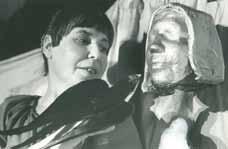
Margret von Martens: Den lycklige prinsen.
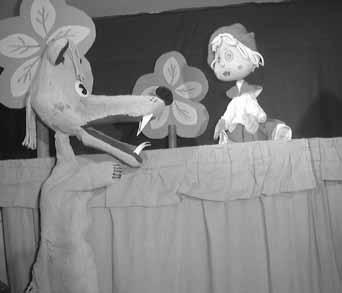
Nukketeatteri Olipa kerran...: Punahilkka
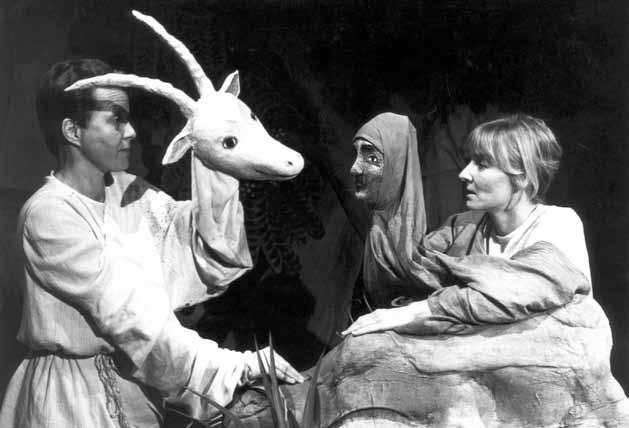
In the latest years Marina Motaleff has made her own solo puppetry. She writes, directs and performs small scale puppet theatre shows touring around with two suitcases full of puppets, objects and props. Marina Motaleff´s main field of work is however acting in drama theatres, films and television. She is also a renowned teacher and theatre educator.
Bilingual puppetry in Vaasa
Puppet theatre Teatteri Peukalopotti -Dockeatern Tummetot (Theatre Little Thumb) was founded in 1976 in Vaasa. Artistic director Kristiina Hurmerinta (b. 1950) has also made avantgardist visual performances for adults under the title of Pandoran näyttämö (Pandora´s stage). Ms. Hurmerinta was also the director of Vaasa International Puppetry Festival in 1980-1990 and the primus motor of long-term puppetry courses, which both have had a deep effect on the development of Finnish puppetry. The theatre was bilingual from the very beginning, which ment also extensive tours in the Nordic countries. Peukalopotti Puppet Theatre´s first artistic leader was Finland-Swedish actor Simeon Rabinowitsch, who was working in Vaasa Municipal Theatre, which gave the young puppet theatre group it´s facilities and resources. Kristiina Hurmerinta started the exploration of modern means of expression in puppetry and object theatre. She invited artists of all fields – dancers, painters, musicians, scenographers – to work with the group, which soon became a modernist and innovative puppet theatre never seen in Finland. Hurmerinta had two great examples in puppetry: one of them was the Finland-Swedish Mona Leo and the other one Polish Anna Proszkowska, who became her partner and leader of puppetry education programmes in Vaasa. Peukalopotti Puppet Theatre closed in 1996 with a magnificent ritual feast Pidot/Gästabud96. Actor Lasse Hjelt (b. 1947) was in the core team of Peukalopotti theatre for ten years in 1979-89 alongside his work at Vaasa Municipal theatre. He was also an active puppetry educator like Kristiina Hurmerinta sharing his knowledge of puppetry and drama acting. Lasse Hjelt moved to Turku in 1989, where he worked as an actor in the Municipal Theatre until 1995. Both in Vaasa and Turku he has also dramatized and directed puppet plays for drama theatres as well as for many Swedishspeaking amateur puppetry groups. After having returned from Turku back to Vaasa Municipal Theatre in 1997 Hjelt has continued making puppet theatre both as an actor/ puppeteer and director. Nowadays Vaasa has again a bilingual puppet theatre, on an amateur basis. In 2006 Italian Cosimo Galiano and Finnish Kirsti Rautamo founded Nukketeatteri Pikku Aasi - Teatrino del Ciuchino (Puppet Theatre Little Donkey). The members of the theatre - teachers and artists working in different fields in Vaasa – have produced several plays, like The Princess of the North and Sea Robbers – in Finnish and Swedish mainly with hand and rod puppets. Not far from Vaasa, in the town of Närpes, amateur puppetry has been very active in the 1980s, when the Association of Women for Peace founded in 1982 their own puppetry company. Local teachers Ritva Granholm and Brita Hannus-Gullmets used puppetry as means of peace education for children during ten years. The members of Närpes Puppet Theatre participated in many puppetry festivals and courses in the 1980s and early 1990s and toured around Finland-Swedish regions.
Inspired by Mona Leo
Mona Leo has inspired many other FinlandSwedish puppeteers, one of them is Kati Bondenstam (b. 1939), who started making animations to the Fennada Film in Helsinki. She studied graphic arts at The School of Design in Helsinki in 1960s and saw Mona Leo´s performances as well as Czech animations by Jiři Trinka. In 1970 Kati Bondenstam made puppetry programs for Finnish Television and its Swedish Programme Unit using glove puppets. In 1974 she met a librarian Cita Reuter and founded an amateur puppet theatre Dockteater Cit-Kat, which toured around Helsinki and Nyland regions with their shows for five years. In 1980 Kati Bondenstam started working with Barbro Wallgren, who had been doing puppetry by herself. They toured six years under the name Hux-Flux in the Swedish-speaking kindergartens, schools and libraries, visited even Åland Islands in 1982, when The Bluebird-company arranged a puppetry festival there. Barbro Wallgren continued as a solo puppeteer with her Dockteater Kamurkan after Kati Bondenstam concentrated on her work as an arts instructor.
Semiprofessional and amateur puppet theatre
The Swedish-speaking amateur puppetry was flourishing in the 1970s and 80s like the Finnish-speaking ones. Many of the groups were born within libraries, like Dockteater Rosetten in 1975 at Karis Library founded by its director Rose-Marie Malm. She has written, dramatized and made puppets for tens of small performances since then until recent years working with her colleagues at the library. Likewise was born the bilingual Nukketeatteri Olipa kerran…. / Dockteater Det var en gång…. (Puppet Theatre Once upon a Time) in Porvoo in 1981, by the initiative of the legendary librarian Anja Pirttilahti. The group, which has been led also by Irmeli Holstein and other library officials has a repertory of 5-6 puppetry plays, directed mostly by professional theatre directors from Finland, Russia and Estonia. Mervi Tammi, a teacher, visual artist and writer from Espoo is a semiprofessional puppetry artist, who has been making her own shows
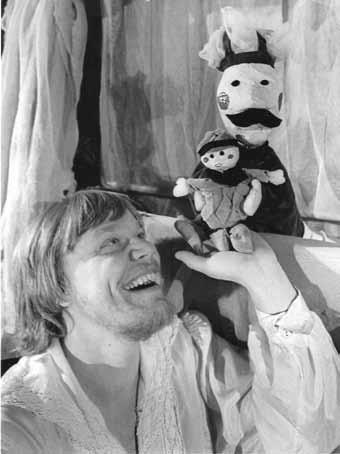
Lasse Hjelt
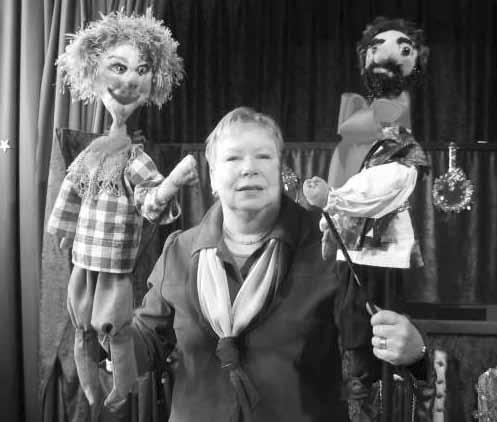
Rose-Marie Malm.
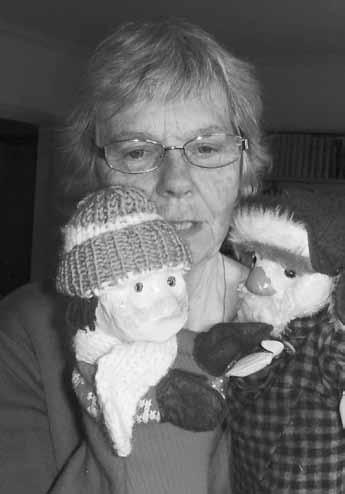
Kati Bondenstam
and led puppetry courses in Swedish and Finnish since 1982 Her solo theatre Mervis Nordiska Dockteater (Mervi´s Nordic Puppet Theatre) has been touring intensively in the Finland-Swedish regions and also in the Nordic countries. In recent years she has made several puppetry projects with the schools of Espoo, where she lives. In Turku Swedish-speaking amateur puppetry flourished in 1988-1997, when a group of kindergarten pedagogues had a theatre group
Uncle Noah’s hat, written and directed by Gösta Kjellin in Theater Green Apple.
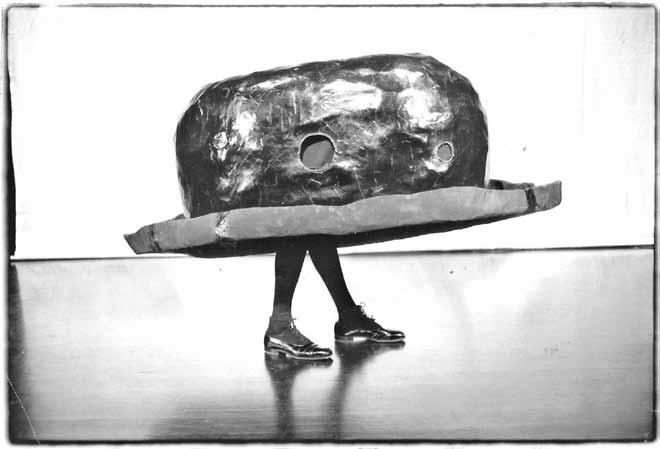
Dockteater Fingerborgen. One of the founders was Pirkko Teir, who invited the famous Finnish puppet maker Kirsti Huuhka to create their puppets. The group, which consisted of 4-6 enthusiasts even had a Puppetry House Fingerborgen in the centre of Turku, where they gave performances, various courses, invited visiting groups and arranged family events for five years in 1992-1997. Lasse Hjelt, who was at that time working in Turku Municipal Theatre, trained the Fingerborgen group members and directed them a play “Ofelia och skuggorna”, a shadow theatre performance. Fingerborgen group and the Puppetry House do not exist anymore, but the members are still using puppetry as pedagogical means in their daily work with children. Nowadays there are only a few Swedish-speaking amateur puppeteers working in Turku and nearby regions. One of them is Marita Reuter in Pargas, who is a teacher and makes her solo performances every now and then.
Puppetry in Åland
The cultural life in Åland Islands is in some extent different than in the rest of Finland. People living and working at Åland are 95-98 % Swedish-speaking, which means a special cultural sphere and traditions. Puppet theatre has existed there since 1910s, when Joel Pettersson started his puppetry activities and had a permanent puppetry scene until 1937. But after that there was a pause of appr. 30 years in puppetry. It has been told that in the 1960s Irja Mansnerus made puppet shows for children in the parish of Mariehamn, the capital city of Åland Islands. In the 1980s Ms. Dolores Westerholm (b. 1937) used puppet theatre as a tool in her work at the Åland Museum. Nowadays she is retired and has a Sagolandet-puppet theatre at home, making performances to her grandchildren. But there is one active, permanent amateur puppet theatre company in the Åland Islands. Dockteater Fågel Blå (The Blue Bird Puppet Theatre) has been making puppetry since 1983. More than 40 plays have been in the repertory and they have had appr.1500-2000 spectators each year in their shows. Dockteater Fågel Blå has given regular shows in the main library of Mariehamn, visited schools and kindergartens all over Åland Islands and Southern Finland with their Swedish-speaking performances. Fågel Blå has actively arranged puppetry courses, seminars and even a puppetry festival in Mariehamn. In 1993 the company produced a play telling of the life of Joel Pettersson, Pojken som hette Joel (The Boy Named Joel), honouring his life and work as an artist and puppeteer. The leader of the company, Ms. Berit Lindqvist (b. 1939) was awarded The Cultural Prize of Mariehamn City in 2002 due to her work in childrens culture. She got acquainted with puppetry already in the 1950s, when studying pedagogics and used puppetry in her work as a kindergarten teacher.
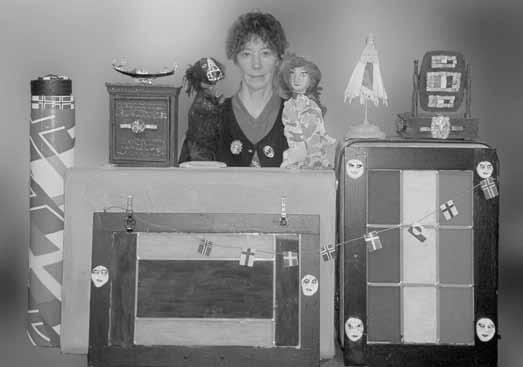
Mervis Nordiska Dockteater (Mervi´s Nordic Puppet Theatre) has been touring intensively in the FinlandSwedish regions and also in the Nordic countries. Professionals in puppet theatre
In the field of professional Finland-Swedish theatre some directors and authors have seriously got interested in puppetry already in the 1970s and 80s. In addition to Margret von Martens and Marina Motaleff, Johanna Enckell (b. 1933) has since 1983 had a great impact on Finnish puppetry. She is a renowned literature and theatre researcher, reviewer, director and dramaturg, who has written and dramatized numerous plays for theatres in Finland, Sweden and abroad. While working at the Universities of Oulu and Helsinki in 1960s and 70s, she acquainted herself with semiotics, structuralism and modern French philosophy and theatre. Antonin Artaud´s theatrical approach and writings gave her the thesis on La poésie de l´espace / The poetry of space. In late 1970s Johanna Enckell worked at Stockholm Municipal Theatre as a dramaturg and started visiting the very famous Marionetteatern led by Michael Meschke. There she saw, how puppetry can affect all kinds of people, be critical and fun at the same time according to the traditions of folk theatre but with new approaches and aesthetics. It gave her a new view into the drama: puppet theatre was a free space for creating new kinds of unexpected scenes, visions and emotions. She wrote two puppetry plays for Marionetteatern, where her future companion Gösta Kjellin (1936-2009) worked as as a dramaturg. Kjellin wrote and dramatized plays for Marionetteatern, e.g. Sagan om havet (Story of the Sea), based on the theme of Ulysses, which was also staged in Finland, Helsinki Municipal Theatre in 1982. He moved to Finland with Johanna Enckell in early 1980s and worked at the University of Helsinki as a lecturer and researcher on Swedish literature and drama. He started writing and directing puppet theatre plays for The Green Apple Puppet Theatre, where he and Johanna brought new, modern approaches to puppetry. Gösta Kjellin directed and wrote 4-5 plays to The Green Apple theatre, e.g. Ukko Nooan hattu (Uncle Noah´s Hat) and Matkalla kymmenen valtakunnan taa / Landet fjärran tio riken härifrån (The Far Away Land), which have been staged also abroad. Johann Enckell has written 15 remarkable puppetry and object theatre plays for several drama and puppet / object theatres in Finland (The Green Apple, Theatre Mukamas, Swedish Theatre in Helsinki, Lahti, Oulu and Espoo City Theatres), in Sweden, France, Switzerland and Czech Republic. In her plays she has often reinterpreted myths of feminity, like in Heliga Birgittas farliga lekar / Pyhän Birgitan vaaralliset leikit (St.
Brigitte´s Forbidden Games) in 1989, Hundrade drömmars Sara / Sadan unelman Sara (Sara with a Hundred Dreams) in 1995 and Bröllopsnatt / Hääyö (The Wedding Night) in 1994 which is a surrealistic object theatre play.
New professional generation
In the early 2000s a new generation of young Finland-Swedish theatre directors, actors and other artists has started making professional puppetry. One of them is actor-director Mikaela Hasán (b. 1968), who got interested in object and puppet theatre when studying at the Jacques Lecoq Theatre School in Paris in 1994. For her puppetry is an equal means of expression in theatre like masks and red clown noses giving new dimensions and possibilities. She has used puppetry in many of her directions since late 1990s: for instance in Theatre Totem in 2000 (Music Your Majesty, dance theatre and puppetry) and Unga Teatern 2005 (Crocodile Gena). In 2005 she directed for a team of Finland-Swedish actors a puppetry play Evig Sommar/ Ikuinen kesä (Eternal Summer) which was aimed at the elderly people and children in the kindergartens. Together with the same team as in Evig Sommar / Eternal Summer (actors Åsa Nybo, Johanna af Schultén and visualist Janne Siltavuori) Mikaela Hasán has made with Heidi Fredriksson an adult puppet and object theatre performance Anatomia Lear (Anathomy Lear) in 2008, based on Shakespeare´s play. It is a clinical study of the story of the old Lear and her daughters, performed with the means of puppets, acting and movement. In both productions the scenographer and visualist is Janne Siltavuori, who has worked already in the 1980s with Peukalopotti Puppet Theatre and in the 1990s at Helsinki Municipal Theatre. Many of the actors who have graduated at Swedish-speaking programme in the Theatre Academy of Finland have started making puppetry alongside with drama acting. Heidi Fredriksson (b. 1971), who graduated in 1998, is one of them. After having worked as a drama actor for several years she has specialized herself on puppetry by studying three years of puppetry in pedagogics at The aRTO Institute Puppetry Education in the 2000s. She is also a trained hospital clown. Together with Tiina Puranen who graduated at Turku Arts Academy Puppetry Department in 1997, she has started in 2009 a new professional puppet theatre FraktTeatern/RahtiTeatteri (Freight Theatre), which will be the first Finland-Swedish one in 40 years since Mona Leo. Tiina Puranen has earlier worked as a solo puppeteer in Turku and made puppet films (not animations) Kejsar-Fina and Båkjungfrun in 2008, telling the stories of people living in the Finland-Swedish Åboland archipelago. Another group of Finnish-Swedish artists of theatre and visual art made in 2006 an absurd and dadaist puppetry performance for adults Kautschuk in Helsinki at the Finland-Swedish Cultural House G18. Visual artists and writers Linda Bondenstam (b. 1977), Stella Parland (b. 1974) and musician Janek Öller (b. 1965) created a parody with marionettes, which were a headless broiler, psychoanalyst Fnoid and a complex ballerina, meeting the Death. There are a few solo puppeteers at the moment working in the Finland-Swedish field. Malin Fagerström has graduated at the Turku Arts Academy Puppetry Education in early 2000s and works in the province of Nyland as an arts instructor. Bilingual Sari Witting (b. 1964), who has been studying literature and theatre at Helsinki University has founded Nukketeatteri Sikuri Dockteater, where Anette Hackman has made puppets. Hackman tours in the schools of Swedish-speaking Nyland with a puppetry project Gruffalo. Together with Anne Lihavainen, who is a professional puppeteer from Porvoo, Sari Witting has made several performances. Christel Grönroos, who has studied puppetry at aRTO-Institute has been performing bilingual puppetry shows in the capital region. Her latest production is Kirjailijan maailma / Författarens värld (The world of an Author), telling about the famous author Astrid Lindgrens life, in 2007. Swedish-speaking professional actress Susanne Marins (b. 1979) has made some puppetry performances at the Österbotten Region next to Vasa. In the same region Sol-Britt ArnoldsGullmets has on an amateur basis created her own Solteatern, where she plays puppet and object theatre. Nowadays the Swedish speaking theatre groups (Teater Geist, Sirius Teatern, Teater Mars and others) and Åbo Svenska Teatern have introduced puppetry in their productions. In 2002 The Helsinki Swedish Theatre staged Ofelias skuggteater, a shadow theatre performance based on Michael Ende´s book, dramatized and directed by Nena Stenius. Marianne Kinberg´ puppetry since 1950s
Last, but not least: there is one more FinlandSwedish puppeteer, who has almost been forgotten. Marianne Kinberg (b. 1926) started making puppet theatre in 1952, after having seen Mona Leo´s performances. She became the invisible assistant of Mona Leo, seated behind the booth handing puppets to her during the performances and in the television. Kinberg graduated as a textile artist at The School of Applied Arts in Helsinki in the 1950s. She continued making puppets in the 1960s at the Finnish Television for various childrens programmes and for several puppet theatre groups like the famous Kasper Theatre. With her own solo puppet theatre she toured in children´s hospitals, in kindergartens and various events in Helsinki and its surroundings. In 1978 she moved to Sweden, where she made puppetry shows for Swedish-Finnish children. In 1998 Marianne Kinberg moved back to Finland and took with her all her puppets, which she donated at The Radio and Television Museum in Lahti. Lately she has been conducting puppetry courses for school children and made together with kindergarten teacher Jaana Kilpeläinen in 2009 a Swedish-speaking puppetry performance for kindergartens. Consequently, the Finland-Swedish puppetry field is rich: there are people of various generations making both professional and amateur puppet theatre. Kalle Nyström´s heritage lives and flourishes.
Maiju Tawast
Edited to Nukketeatteri Magazine by Timo Väntsi. Tawast had her lecture about FinnishSwedish Puppetry in Rovaniemi 7 Solos Festival August 2010.
